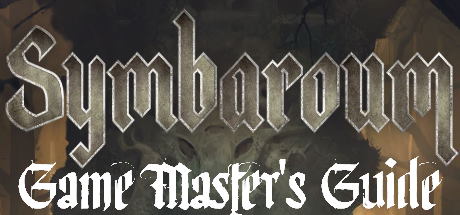Or how to make sure that the trip to Davokar goes just smooth enough
Free League
Genre: Tabletop RPG
Developer: Free League Publishing
Publisher: Free League Publishing
Release date: 26 May, 2020


The Game Master’s guide for Symbaroum is the final of the “core” set of expansion books, joining the ranks of the Monster Codex and Advanced Player’s guide. These are the books that should be useful no matter what kind of campaign you’re playing, with the other books that have been released outside the core expansions being focused on expanding certain areas and as well as pre-written scenarios and a campaign.
The Game Master’s guide is, as the name would imply, a book meant to aid the game master and as such it’s full of advice on how to run the game smoothly, how to deal with problems that might pop up as well as guidelines for how to run certain types of campaigns and so on. It does assume that you have the previous books, the Advanced Player’s Guide and the Monster Codex for some of its content. Like the Advanced Player’s Guide there’s a lot of different things in this book, so it’s hard to sum it up neatly. The choice is either to skim over a lot of things or go relatively in depth with each individual section. This review will do the later, so prepare for a long one.
This review is based on the Swedish version of the game. A few names and terms might differ between the two, but the content should be more or less the same.

A Guide on How to Game Master
The first part of the book might be the most or the least useful section, depending on how experienced of a game master you are. It details how to set up and run a campaign, how to make the game world feel interesting and alive and also how to deal with differing expectations and views from players. If you’ve played RPGs for a while most of what’s here should sound familiar.
Similarly to the core rulebook, the Game Master’s guide starts with a pretty lengthy segment on the game world, although while the core rulebook described the recent history of the world and different places, the GM’s guide describes how to make the game world into something that works for your game. It’s an interesting choice to put this at the very start. Here you’ve got guidelines for deciding on a theme and tone for the world as well as the main conflict and secondary things that fleshes it out and makes it feel more alive.
There’s then a segment on how to structure a campaign, how to start it, how to introduce recurring antagonists and allies and so on. Basically it gives a rough idea of what you need in a campaign and how to implement them in a good way. There’s some good advice here that might not be entirely obvious to a new GM, like if the players are going up against a group it’s usually better to let the players meet some of the people on the lower rungs of the hierarchy first and then go from there, before letting them meet the leader face to face, and also gives examples of when it’s a good idea to break this rule. There’s also a short guide for how to design an adventure and an adventure location with examples from an existing adventure from the first adventure pack to illustrate what the writers mean. This segment is likely going to be great for anyone who’s never ran an RPG before, but for someone who’s an experienced game master there are just a few nuggets of useful information.

Then there’s a section on how to handle issues in the group, with some of these being problems that most game masters will run into at some point unless they just play with the same tightly knit group for years. For an example, what do you do when one player enjoys building highly optimized characters and another player really don’t care for that sort of stuff? The player who does not enjoy spending hours optimizing their character can easily feel bored and left out if they’re never given the chance to shine. Or how do you handle players with different expectations for the game?
Sandwiched between the last two segments is a short section that deals with how to handle players playing multiple characters who are affiliated. Like say a mercenary company, where a player might play both the commander and the officer handling supplies, and how you structure such play. It’s not about playing multiple characters at once, but rather about giving players more than one character to chose from. It’s a pretty well thought out segment overall, and despite just being 2 pages it gives a good idea of what’s necessary to do to make something like this work.
Part of the same section of the book there’s also something that feels like it should be a bit later in it, and that’s a guide on how to set adventures (or at least parts of adventures) in either the Underworld, Yonderworld or Spirit World. there’s a segment in the book that goes through adventuring in Davokar and it would probably have made more sense to put this after that section, instead of in the “How to game master” section. The underworld is straightforward enough, it’s the world underground, and its vast cave systems, some of which may or may not have been caused by world serpents. The yonderworld is a ruined world(s) beyond the normal one, with ashen deserts and where daemons make their home. And finally the spirit world which is real physical world where spirits linger. All of these comes with ideas for adventures, a bit of backstory and also an encounter table each that gives an idea of what players might run into.
The final part of this section of the books deals with what the author calls “goal oriented roleplaying”, that is if the players play with a specific goal in mind, like establishing an outpost. Guidelines for how to do five kinds of goal oriented playing, which is more player lead than GM lead, are in the book, two of which has been mentioned other books. That is establishing an outpost, which was first published in Thistle Hold – Wrath of the Warden, conquest, holy mission and monster hunting, which is part of the Monster Codex and finally doing expeditions into Davokar. At least the monster hunting section is not identical to what previously has been published, though it does touch on the same things. (I can’t speak for the part about Thistle Hold – Wrath of the Warden, as I’ve not read that yet) It is missing some information that would be useful for those who don’t own the monster codex, like payment for hunting different monster types.
New and Improved Challenges
Challenges are an important part of any RPG, and this chapter details some of the common ones that people will run into in Symbaroum. This is the chapter that is likely to be the most useful to experienced game masters, as it deals with some Symbaroum-specific things, most importantly journeying through Davokar.

Before that though, there’s some other things and the first one is traps. Traps is something that has fallen out of fashion in modern RPGs, and for a good reason, they way they’ve traditionally been implemented is pretty boring as they’ve pretty much been a luck-based resource drain. The example traps in the GM’s guide are traditional, like poison darts, acid sprays and spears shooting out of the floor. But here there’s also a short explanation of the mechanism and how to disarm them, treating the traps more like deadly puzzles.
There’s a section on pitched battles as well as one managing a domain, and these go a bit hand in hand, as managing a domain can lead to battles. The pitched battle rules are relatively abstract and does not deal with things such as troop composition or other such factors that in reality would impact the outcome of a battle, but the quality of the troops do. Basically before a battle the strength of both sides are added up, with higher quality troops counting as more than one soldier for the calculations, and then the player’s actions can further influence the outcome the battle by either leading the troops, or fighting themselves. It’s a simple system for representing a battle, and making it interesting will require a bit of work from both the GM and the players in order to describe the events, but it works and it does not get bogged down in details. Similarly to the pitched battles managing a domain can be pretty abstract, and it’s up to the players and GM to give it some life, but it’s also flexible enough that it should not be too hard to work with whatever type of holding you can come up with, not just the example ones from the book, with very little work.
Five pages about social play and challenges are next. This segment deals with how to run intrigues and handle social interactions with the different factions, and also what the factions value and what they dislike. There’s also a sheet included with the book that can be used to keep track of a character or group’s relationship with all the major factions, as well as major NPCs from those factions that they have special relationships with. Following the guidelines for how to do social challenges are also some more information about the social structures of Ambria region. This is overall a handy section and relationship sheet is an interesting way of keeping track of what people think of the characters in longer campaigns, as there are a lot of different groups who have very different views on things, particularly things concerning trips into Davokar.
Speaking of Davokar, there’s a substantial section of the book dedicated to venturing through it, and all the trouble that can befall people trying to do so, as well as what they might actually find in there. There are reasons why someone would even dare to venture into the dangerous forest other than just “because there are valuable treasures in there”, what preparations can and should be undertaken as well as mishaps and simple survival rules (people need to eat after all). There’s also a lot of tables that can be used to randomize things in this section, enough that a trip through Davokar can in theory be largely randomized, though they probably work better as inspiration. On top of that there are 4 pages on ruins, which don’t necessarily have to be in Davokar itself, although Davokar is home to a lot of ruins from the old Symbar empire. Ruins can also be pretty much entirely randomized using the tables. In the Davokar section is also a hexagon map of Davokar that shows what parts count as Bright Davokar, Wild Davokar and Dark Davokar, where different coloured hexagons show which region is which. It’s a useful map but it’s hard to read under poor lighting conditions, as the contrast between the hexagons is bit too low, but other than that this section is likely one of the most useful from a purely practical point of view, as Davokar plays such an important role in Symbaroum.

Ceremonial magic was an unexpected thing to find in a book like this, but it actually makes sense to put it in a GM’s guide as it’s not really something that the players should mess with on their own. The cost is just too great. Ceremonial magic is more involved and requires both more preparation and people than ritual magic, and its effects are long-lasting, if not permanent. It’s also dangerous, so dangerous that it’s outlawed in Ambria for those who don’t have the queen’s permission to use it, and if something goes wrong, or even right, the consequences can be dire. Ceremonial magic is in other words mostly meant as something NPCs do, likely NPCs opposed to the players. What’s presented here is more guidelines than strict rules, which for things meant for NPCs is fine, particularly with something as diverse as ceremonial magic. There are also 16 ceremonies presented in the book ranging from raising the dead, to creating a plague of insect swarms to earthquakes and summoning a daemon court, with the negative effects these ceremonies can have on the world around them listed (beyond the obvious). Summoning a daemon court will for an example forever mark the spot as corrupted, and once per year this corruption with blossom and a portal to the yonderworld will appear.
The last part of this chapter explains how to create and run legendary creatures. These are more or less boss monsters that are stronger and more impressive than most others. There are guidelines for making these interesting and more than just damage sponges with suggested weak spots that players can exploit. Pointing out that big scary creatures need some kind of weak spot to make them interesting might seem obvious when you read it, but how many pre-made adventures are there not out there that just have a big badie at the end that just have greatly inflated stats and powers? There are also three example creatures. This section works well with the advice given earlier on how to structure a campaign.
Doling Out Rewards
The final, and shortest, chapter of the book is about what tend to motivate players the most: Rewards. It gives advice on what kind of rewards are the most useful for characters depending on how experienced they are, be it riches or more experience points, but more interestingly it puts forth the idea of giving both boons and burdens as rewards. The later might sound counter-intuitive, but burdens depending on what the characters have gone through is an interesting way of giving the players something to use for roleplaying purposes. They’re battle scars, each burden telling their own story (and adding burdens also give players more experience to spend on other things). This is then followed by a section on major artifacts. Where the players guide had minor ones, these are the big artifacts that have a large impact on the game. There are 27 artifacts in total list here and they all have multiple effects. There’s for an example a chain that can be laid out as a trap and which will entangle an opponent that walks over it, or it can be used as a chain whip, there’s a flute that can play music so beautiful that people who hear it will feel compelled to pay the user even if they’re not really interested in hearing flute music, but it can also be used to charm animals and so on. Artifacts do corrupt their users though. There are also some adventure ideas for each artifact.
Layout, Art and Quality
As with previous Symbaroum books, this one is really sturdy and feels like it can take a lot of use. The paper is equally thick as in past books and the print quality is once more excellent. Free League is not cutting any corners here.
The art is once more by Martin Grip, and it’s as good as always. There’s not as much art in this book as in the core rulebook or monster codex, but what’s here is really well made and sets the tone well. There are a few illustrations in the trap section that differs and are more meant to show how a trap works than to be pretty art. It looks almost like something out of Grimmtooth’s Traps, though of course less comedic in nature.
As for the layout of the book itself, it’s overall good, though there’s one section that feels like it should belong in another part of the book. This is not a book you’ll flip through a lot during play though, so that’s not a big issue.
Closing Thoughts
I have to admit that I don’t own many Game Master’s guides, and the ones I do own are at least 15 years old, so it’s possible that this has become standard in recent years, but I was positively surprised to see certain things included in this one, chiefly among them a section on how to deal with imbalanced parties and player expectations. That’s something I’ve seen quite a few groups struggle with over the years, and even seen one completely split apart because of it.
It feels like there are a lot of niche things in this GM’s guide, things that won’t necessarily see a lot of use, like multiple characters, pitched battles and so on. That’s not a bad thing, and the inclusion of these things in a book like this might make people more willing to give it a try, and not just play the standard adventuring party.
I had a few gripes with this book, like the hard to read hex-map of Davokar, but I still think this is a really good Game Master’s guide. There’s a lot of good information in it, and even some tips for things I had not really give much thought before. It does rely a fare bit on owning the Monster Codex and Advanced Player’s Guide though, with some parts of the book not being particularly useful without one or both of those. Traps for an example is something that first gets introduced in the Advanced Player’s Guide, and the legendary creatures are not really useable without the Monster Codex. So if you have to make a choice, get this book last out of the three. But if you can afford to get all three, then they’re all useful for running Symbaroum, but none of them feels strictly necessary.










